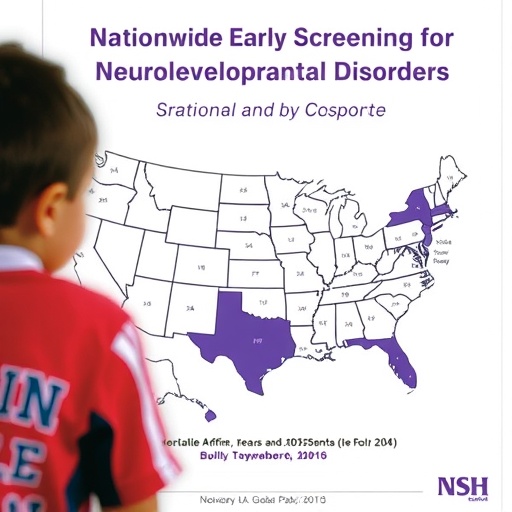In a groundbreaking update set to reshape pediatric healthcare, a nationwide health screening program aimed at early identification of neurodevelopmental disorders in children under six has undergone critical revisions. This correction, recently published by Cha, J.H., Ryu, S., Park, M., and colleagues in Pediatric Research, underscores the ongoing evolution and refinement of large-scale developmental screening efforts. Given the rapid advancements in neurodevelopmental science and public health strategies, these amendments enhance the accuracy and utility of early screening protocols, potentially altering the broader landscape of pediatric neurodevelopmental diagnostics.
Early identification of neurodevelopmental disorders such as autism spectrum disorder (ASD), attention-deficit/hyperactivity disorder (ADHD), and developmental delays has long been recognized as essential for timely intervention and improved clinical outcomes. The nationwide health screening program detailed in this publication represents one of the most comprehensive efforts to systematically screen children before age six at a population level. The correction clarifies aspects of methodology, data interpretation, and implementation strategies that are critical for clinicians, researchers, and policymakers who rely on this program as a template for early neurodevelopmental assessment.
Within the framework of child neurodevelopmental screening, the technical sophistication lies in balancing sensitivity and specificity—accurately flagging children who need further evaluation without overwhelming healthcare systems with false positives. The revised details provided by Cha et al. highlight adjustments made to screening instruments and algorithms, reflecting recent advances in neuropsychological testing and biomarker integration. Such corrections ensure that the screening tools remain culturally and developmentally appropriate while maintaining scalability across diverse healthcare settings.
This screening initiative leverages multidisciplinary expertise encompassing developmental pediatrics, child psychiatry, neurology, and public health policy. The correction notably elaborates on previously underreported validation studies and cross-references normative developmental data, reinforcing confidence in the screening criteria’s robustness. These refinements indicate a conscious effort to harmonize clinical practice with emerging scientific evidence, fostering a dynamic interplay between research findings and real-world application.
Technologically, the program incorporates cutting-edge digital platforms facilitating remote assessments and parental reporting mechanisms, which were fine-tuned in light of the correction. The clarified protocols emphasize standardization of data collection processes and highlight the importance of training healthcare providers in nuanced interpretation of screening outputs. This multidimensional approach allows for early detection not only in clinical settings but also within community and primary care environments, addressing disparities in access to developmental healthcare.
A key element illuminated in the correction concerns the longitudinal tracking component embedded within the screening program. Continuous monitoring over the critical developmental window from infancy to preschool age allows clinicians to observe developmental trajectories rather than rely on singular timepoint assessments. These longitudinal data, enriched by the correction’s methodological refinements, offer unprecedented insights into neurodevelopmental patterns, enabling proactive adjustments in therapeutic interventions tailored to child-specific needs.
Underpinning the screening program’s success is the integration of biostatistical models that parse complex developmental data into actionable clinical insights. The correction elaborates on the statistical treatment of confounding variables and the calibration of predictive models, optimizing the trade-offs between over- and under-diagnosis. This sophisticated data handling exemplifies the intersection of biomedical informatics and neurodevelopmental science, forging a new frontier in precision screening.
Moreover, the correction scrutinizes the program’s public health impact assessment, incorporating newly derived metrics for evaluating screening efficacy at a population scale. By refining outcome measures such as positive predictive value in diverse demographic cohorts, the revised framework bolsters healthcare equity and resource allocation. These advancements underscore a commitment not only to individual child health but also to systemic improvements in developmental disorder detection and management.
Beyond the clinical and statistical intricacies, the correction also addresses ethical considerations inherent in widespread developmental screening. The authors articulate guidelines for informed consent, privacy protections, and culturally sensitive communication with families. In doing so, they navigate the delicate balance between early intervention benefits and potential psychosocial risks associated with early neurodevelopmental labeling, advancing ethical standards in pediatric screening programs.
This nationwide program, as refined through the published correction, exemplifies a paradigm shift toward proactive, data-driven pediatric neurodevelopmental care. By setting rigorous standards for early detection and interdisciplinary integration, it lays the groundwork for transformative improvements in childhood developmental health. The correction’s transparency and thoroughness also signal the scientific community’s dedication to continuous quality improvement in this rapidly evolving field.
Importantly, the corrected data reaffirm that universal screening before age six is both feasible and impactful when underpinned by evidence-based methodologies. The authors project that widespread adoption of such refined programs can lead to earlier therapeutic engagement, improved developmental outcomes, and reduced long-term societal costs related to neurodevelopmental disabilities. This evidence-based approach may inspire global health systems to adopt similar models adapted for local contexts.
In summation, the correction by Cha and colleagues serves as a pivotal touchstone for optimizing neurodevelopmental screening frameworks worldwide. It encapsulates the maturation of a complex health initiative through rigorous re-examination and adjustment, ensuring that early childhood neurodevelopmental disorders are identified with unprecedented precision and equity. As pediatric healthcare continues to embrace personalized and preventive paradigms, such foundational work will prove essential in shaping future generations’ developmental trajectories.
Subject of Research: Nationwide developmental screening program for neurodevelopmental disorders in children under six.
Article Title: Correction: Developmental screening of neurodevelopmental disorders before age 6: a nationwide health screening program.
Article References:
Cha, J.H., Ryu, S., Park, M. et al. Correction: Developmental screening of neurodevelopmental disorders before age 6: a nationwide health screening program. Pediatr Res (2025). https://doi.org/10.1038/s41390-025-04064-3
Image Credits: AI Generated




